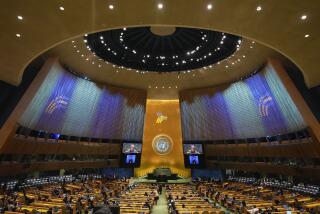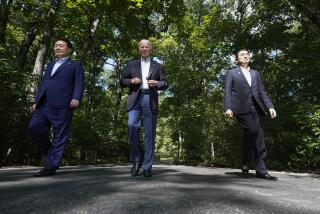Reagan to Meet Gorbachev Dec. 7 : Will Sign Missile Pact in Washington; 1988 Moscow Meeting Also Planned
- Share via
WASHINGTON — President Reagan announced Friday that he and Soviet leader Mikhail S. Gorbachev will meet in Washington starting Dec. 7 for summit talks that the President said could turn the anniversary of the 1941 bombing of Pearl Harbor into a day remembered as the beginning of superpower peace.
Standing between Secretary of State George P. Shultz and Soviet Foreign Minister Eduard A. Shevardnadze, Reagan said he and Gorbachev will sign a treaty banning intermediate-range nuclear missiles, the first superpower arms control agreement in eight years.
Reagan added that he and Gorbachev agreed to meet in Moscow during the first six months of next year, possibly to sign a treaty cutting in half the superpower arsenals of long-range strategic weapons.
Treaty Near Completion
A few details remain to be worked out on the intermediate-range pact, which would outlaw missiles with ranges of between 300 and 3,000 miles, but Shultz said the treaty is so close to being complete that if it is not ready by the start of the summit, “Mr. Shevardnadze and I are going to get kicked in the rear, and very hard, by our leaders.”
Gorbachev’s agreement to make the first visit to the United States by a Soviet leader since Leonid I. Brezhnev came in 1973 was a dizzying reversal of the position he had taken just a week earlier. At the end of a Kremlin meeting Oct. 23, Gorbachev shocked U.S. officials by refusing to set a summit date after Shultz would not promise that the United States would agree to curbs on its Strategic Defense Initiative, the space-based missile defense system also known as “Star Wars.”
Gorbachev seemed to make all of the concessions required to put the summit meeting back on track. He sent Shevardnadze to Washington to fix the summit date that he could have set himself a week earlier. And he appeared to relax his insistence on restrictions on anti-missile defensive weapons as the price of progress in other areas of arms control.
Shultz told a press conference that the Administration made no concessions between the Moscow and Washington meetings and was unable to explain the Soviet turnabout. At a separate press conference, Shevardnadze agreed that Washington made no new concessions, but he said the two sides now agreed on the “concept and agenda” for the summit--something he said was not determined last week.
A joint announcement said that, in the coming months, “both sides will work toward early achievement of a treaty implementing the agreement to reduce strategic (long-range) offensive arms by 50%, which could be signed during the President’s visit to Moscow.”
Soviets Link Issues
Unlike previous joint statements, that sentence was not followed by a reference to restrictions on space and defensive weapons. But Shultz said the Soviets “continue to talk about (strategic offensive and defensive systems) as though they were linked.” Last year’s Reagan-Gorbachev summit in Iceland broke down in a dispute over the Strategic Defense Initiative.
Reagan said that the United States is prepared to discuss defensive systems but that “I’ve made it clear--and they have not rejected this--that there’s no way that we can give up SDI, which we believe is offering an opportunity for peace for the world.”
The President said U.S. and Soviet negotiators will strive for “a formal, verifiable treaty” to halve the arsenals of strategic weapons that can reach targets more than 3,000 miles away. “I hope to sign (the pact) during a visit to Moscow next year,” he said.
A strategic arms reduction treaty would have far more military significance than the intermediate-range nuclear force pact that Reagan and Gorbachev plan to sign in December. But there is no guarantee that the two sides will be able to reach agreement during the six to eight months left before the U.S. presidential election season reaches a point that would make additional U.S.-Soviet summit meetings unlikely.
At the conclusion of their summit in Geneva in 1985, Reagan and Gorbachev announced that they would meet in the United States in 1986 and in the Soviet Union in 1987, but they failed to keep to that schedule.
Reagan clearly was elated that Gorbachev had finally set a date for his visit to the United States. When asked if he is concerned that the summit would start on Dec. 7, the 46th anniversary of the surprise Japanese bombing that brought the United States into World War II, Reagan said, “Wouldn’t it be wonderful if Pearl Harbor day would become superseded by the day that we began the path to peace and safety in the world through disarmament?”
Treaty Virtually Complete
Shultz said the intermediate nuclear force treaty is virtually complete. Under provisions already agreed to, the Soviet Union would destroy all of its shorter-range systems--those capable of hitting targets 300 to 600 miles away--during the first 18 months after ratification of the pact.
Both nations would dismantle their medium-range missiles--those with ranges of between 600 and 3,000 miles--within three years, with the Soviets moving more quickly in the first two years because they have far more of the missiles. The United States has no weapons in the shorter-range class.
Shultz said a few narrow issues remain to be settled. He said the extent of Soviet on-site inspections at missile bases in Western Europe is one of the remaining snags. But he predicted that this issue will be resolved soon.
According to the joint statement, Reagan and Gorbachev agreed to the now-familiar four-point agenda for the summit: arms control, human rights, regional conflicts and bilateral issues. Shultz said that, in advance of the summit, high-level U.S. and Soviet teams will thrash out the human rights and regional issues to prepare reports for Reagan and Gorbachev.
The human rights discussions will be handled by Deputy Secretary of State John C. Whitehead and a Soviet deputy foreign minister, while the regional matters will be handled by Under Secretary of State Michael H. Armacost and Yuli M. Vorontsov, one of two Soviet first deputy foreign ministers.
Shevardnadze said Gorbachev will spend two or three days in the United States, the entire time in Washington. He said the Soviet leader would have liked to have seen more of the country but did not have time for such a trip. The United States had proposed a coast-to-coast summit that would have included a stop at Reagan’s Santa Barbara ranch.
Nunn Offers Praise
The Democrats most respected foreign policy spokesman, Sen. Sam Nunn (D-Ga.), gave Reagan high marks for his handling of Gorbachev’s refusal last week to set a summit date.
“The Administration frankly has handled the last week’s events rather well,” Nunn, chairman of the Senate Armed Services Committee, said. “Gorbachev tried to make us pay a price for the summit, and President Reagan handled it well.”
As for Gorbachev, Nunn said, “We’ve seen a new Soviet leader who can admit at least implicitly that he made an error.”
Nunn warned the Administration against rushing to complete the intermediate nuclear force agreement to satisfy the summit schedule. He said it would be better to allow the summit to slip back to January or February than to make hasty decisions on the remaining issues.
The emerging treaty seemed to win far more favor with Democrats--who control the Senate, which will be called upon to ratify the pact--than with Reagan’s fellow Republicans.
Rep. Jack Kemp (R-N.Y.) said the United States should not sign a nuclear arms control agreement until the Soviet Union has agreed to cuts in conventional, non-nuclear weapons and guaranteed basic human rights to its own citizens.
“This summit may fundamentally endanger the security of future generations,” said Kemp, a candidate for the Republican presidential nomination.
More to Read
Sign up for Essential California
The most important California stories and recommendations in your inbox every morning.
You may occasionally receive promotional content from the Los Angeles Times.













